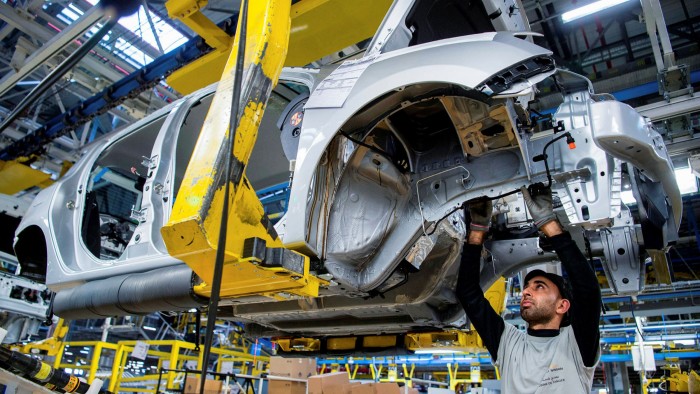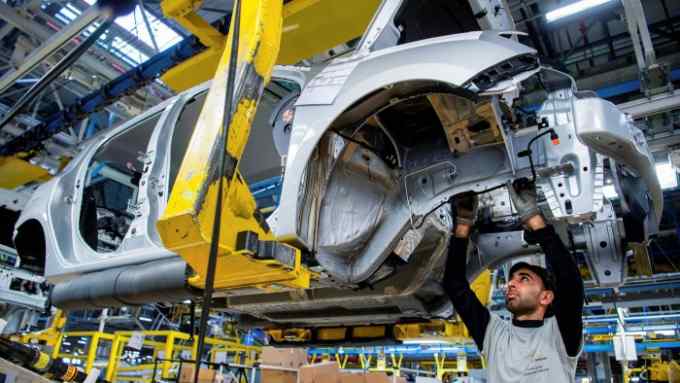How Morocco transformed itself into a carmaking hub

Simply sign up to the Automobiles myFT Digest -- delivered directly to your inbox.
Each year, Moroccans buy about 160,000 new cars — a relatively small number for a population of 36m. Yet, despite modest sales, the kingdom has gained critical mass as an automotive manufacturing hub.
In 2018, it surpassed South Africa as the biggest exporter of passenger cars on the continent.
“Just as you’ve seen the car industry move into eastern Europe, then the next logical step is north Africa,” says David Cowan, chief economist for Africa at Citibank.
Exports in 2019 hit roughly $10bn and, although they dipped in 2020 after a pandemic-related demand-and-supply crunch, they have recovered this year.
About 80 per cent of the roughly 400,000 cars produced are sold to Europe, with France, Spain, Germany and Italy the top destinations. Other markets include Turkey and the Middle East, with a smattering going to the rest of Africa — a market now theoretically more accessible thanks to the African Continental Free Trade Area, a trading bloc that came into effect this year.
The Moroccan car industry now directly employs some 220,000 people, most of whom work for roughly 250 suppliers that have sunk roots in the country since carmakers began to gain real traction more than a decade ago.
The presence of companies such as Valeo of France, Varroc Lighting Systems of the US and Yazaki and Sumitomo of Japan shows that Morocco has had some success in forcing a backward integration of the industry, by stipulating the use of locally-based suppliers.
Marc Nassif, managing director of Renault in Morocco, the biggest manufacturer in the country, says the French company sources parts from seats to axles — almost everything bar powertrains — from local suppliers. He estimates about a third of the companies are Moroccan while the rest are foreign suppliers based in the country.
Local content accounts for 60 per cent of the final product, he says, a figure he expects to rise to 65 per cent.
“The state is extremely demanding but also extremely supportive,” says Nassif, who argues that Morocco’s much-trumpeted tax breaks and investment incentives — which he says are actually less generous than those offered by some other countries — are not the main reasons for success.
As well as good infrastructure — most recently a new high-speed rail link between Casablanca and Tangier, where the bulk of Renault production takes place — he highlights consistency of policy. Manufacturers can go to a “single window” in the trade and industry ministry rather than battling against competing bureaucratic fiefdoms, he says.
In terms of exports, they also benefit from a suite of Moroccan free trade agreements with Europe, the US, Turkey, the United Arab Emirates and elsewhere. Locally recruited staff are trained at Moroccan technical institutes, another sign of a determination to push up the value chain.
How Morocco has moved from an insignificant car manufacturer just a few decades ago to one challenging the likes of Poland, the Czech Republic and even Italy is a story of state intervention. One article on the subject was titled, “Yes, We Plan”.
Joe Studwell, an expert in industrial policy in both Asia and Africa, regards the growth of Morocco’s car industry, particularly in conjunction with the development of Tanger-Med, an industrial port complex, as an example of what governments can do when they are serious. He says the key is to provide state oversight with rigorous private-sector competition and a strong focus on exports to foreign markets where shortfalls in either efficiency or quality are ruthlessly exposed.
Geography also helps. “If you are in Tangier you are just across from Spain, but you have a totally different cost structure,” he says, referring to Morocco’s proximity to Europe and its cheaper wages.
More from this report
Pandemic exposes vulnerabilities in Moroccan economy
Critics flag opposition weakness in Morocco’s new parliament
Morocco tourism struggles despite vaccine progress
Morocco asserts its power as diplomatic spats simmer
Moroccan lenders shore up small businesses but risks loom
Casablanca financial hub’s fortunes tied to national economic strategy
Labour costs are about one quarter of those in Spain and lower than in eastern Europe. For entry-level cars like Renault’s Dacia brand, where labour makes up a higher proportion of the vehicle cost, that is a key incentive for locating in Morocco, says Nassif.
There are strong signs the industry will expand further. In 2019, Peugeot opened a $600m plant in Kenitra, north of Rabat, which has started to produce the Peugeot 208 and will have capacity to make 200,000 vehicles by the end of the year. BYD, a Chinese electric vehicle manufacturer, has signed a memorandum of understanding with the government to open a plant in Kenitra that could mark a further technological step change. Hyundai, the Korean carmaker, which recently quit Algeria, may now consider setting up in Morocco, according to reports.
Still, there is room for caution, says Cowan of Citibank. “If I were to walk you around the factory in Tangier, there are not many people. There are a lot of robots. The unemployment numbers have not substantially budged.”
For the car industry to have a bigger impact on jobs and income, he says, yet more progress must be made on sourcing high-value components locally — including batteries and perhaps eventually powertrains.
“How to develop an auto components industry that feeds into production? That’s their next challenge and that to me will be the make-or-break of this as a project.”

Comments